Fisher Paykel WA3927G1 User Manual

|
|
WashSmart clothes washer |
Installation instructions |
|
and User guide |
Laveuse WashSmart |
Instructions d’installation |
|
et Guide d’utilisation |
US CA

 WARNING!
WARNING!
Electric Shock Hazard
Read and follow the IMPORTANT SAFETY INSTRUCTIONS outlined in this User Guide before operating this appliance, pages 3 – 5.
Failure to do so can result in death, electric shock, fire or injury to persons.
Please note: to obtain maximum efficiency, your Fisher & Paykel WashSmart washer has the ability to learn and adapt to the local environment. This may take several wash cycles, therefore maximum energy efficiency may not be achieved until a number of wash cycles have been completed.
This usually takes about 5 cycles.
English |
Page 1 – 47 |
|
|
Français |
Page 49 – 95 |
|
|
Contents |
|
|
|
|
1 |
US |
|
|
|
|
CA |
Introduction |
2 |
|
|
|
|
||
Important safety instructions |
3 |
|
|
Installation instructions |
6 |
|
|
Water supply |
7 |
|
|
Leveling |
11 |
|
|
Before you do your first wash |
15 |
|
|
Getting started quickly |
16 |
|
|
WashSmart controls |
18 |
|
|
WashSmart safety features |
19 |
|
|
Eco Active™ wash |
20 |
|
|
Sorting and loading |
21 |
|
|
Detergent |
22 |
|
|
Before you wash |
23 |
|
|
Bleach |
23 |
|
|
Fabric softener |
23 |
|
|
Wash cycles |
25 |
|
|
Wash options |
26 |
|
|
Customizing wash cycles |
31 |
|
|
Changing pre-set options |
32 |
|
|
Caring for your washer |
37 |
|
|
Before you call for service |
39 |
|
|
Solving operating problems |
41 |
|
|
Solving wash problems |
43 |
|
|
Limited warranty |
45 |
|
|
How to get service |
47 |
|
|
Important!
SAVE THESE INSTRUCTIONS
The models shown in this User Guide may not be available in all markets and are subject to change at any time. For current details about model and specification availability in your country, please visit our website listed on the back cover or contact your local Fisher & Paykel dealer.
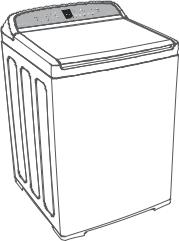
|
|
|
Introduction |
US |
2 |
||
CA |
|
|
|
|
|
Welcome to WashSmart |
|
|
|
||
|
|
Thank you for buying a Fisher & Paykel WashSmart clothes washer. We are proud of this washer |
|
|
|
and trust it will serve you well for many years. |
|
|
|
At Fisher & Paykel we aim to provide innovative products that are simple to use, ergonomic |
|
|
|
and kind to the environment. Thousands of tonnes of washing and over 80 years of laundry |
|
|
|
experience have been programmed into your clothes washer to help give you the best |
|
|
|
possible performance. |
|
|
|
Your Fisher & Paykel WashSmart washer has an extra large capacity, and numerous wash cycles |
|
|
|
and options so you can perform every wash task with ease and spend less time in the laundry. |
|
|
|
With the ability to select the most efficient water level for each load, your WashSmart makes it |
|
|
|
kinder on your wallet and the environment. |
|
|
|
Please take the time to read these instructions carefully before you begin using your machine. |
|
|
|
Following the advice in this user guide will ensure you get the performance you expect from |
|
|
|
your machine and that you get the best possible wash results. |
|
|
|
We hope you enjoy your new washer. We have certainly enjoyed designing it for you. |
|
Fig.1 WashSmart washer

Important safety instructions |
|
|
3 |
US |
|
|
|
CA |
Read all safety information before using |
|
|
|
|
|
Many washers are located near a gas dryer or a water heater in the home. |
|
|
 WARNING!
WARNING!
Risk of Fire Hazard
For your safety the information in this manual must be followed to minimize the risk of fire or explosion or to prevent property damage, personal injury or loss of life.
Do not store or use gasoline or other flammable vapors and liquids in the vicinity of this or any other appliance.
Installation and service must be performed by a qualified installer, service agency or the gas supplier.
What to do if you smell gas
■■DO NOT try to light any appliance.
■■DO NOT touch an electrical switch; do not use any phone in your building.
■■Clear the room, building or area of all occupants.
■■Immediately call your gas supplier from your neighbor’s phone. Follow the gas supplier’s instructions.
■■If you cannot reach your gas supplier, call the fire department.
Water heater safety
Under certain conditions hydrogen gas may be produced in a water heater that has not been used for two weeks or more.
HYDROGEN GAS CAN BE EXPLOSIVE UNDER THESE CIRCUMSTANCES.
If the hot water has not been used for two weeks or more, prevent the possibility of damage or injury by turning on all hot water faucets and allowing them to run for several minutes before using any electrical appliance which is connected to the hot water system. This will allow any hydrogen gas to escape. Since the gas is flammable, do not smoke or use an open flame or appliance during this process.
SAVE THESE INSTRUCTIONS

US 4 Important safety instructions
CA
 WARNING!
WARNING!
Risk of Fire, Electric Shock and Injury to Persons Hazards
Follow the safety precautions outlined in this User Guide.
Failure to do so can result in death, electric shock, fire or injury to persons.
Important safety precautions
■■Read all instructions before using the appliance.
■■Use this appliance only for its intended purpose as described in this User Guide.
■■This washer must be properly installed and located in accordance with the Installation Instructions before it is used.
■■This washer must be properly grounded to conform with all governing codes and ordinances. Follow details in the Installation Instructions.
■■Do not install or store washer where it will be exposed to temperatures below freezing or exposed to the weather.
■■Connect to a properly rated, protected and sized power supply circuit to avoid electrical overload.
■■Connect to adequate plumbing and drain facilities as described in the Installation Instructions.
■■Turn off water faucets when the washer is not in use to relieve pressure on hoses and valves and to minimize leakages if a hose or valve should break or rupture.
■■Do not repair or replace any part of the appliance or attempt any servicing unless specifically recommended in this User Guide or in published user repair instructions that you understand, and have skills to carry out.
■■When disconnecting the appliance pull by the plug rather than the cord or junction of cord to avoid damage to the cord or junction of the cord and plug.
■■Make sure that the cord is located so that it will not be stepped on, tripped over or otherwise subject to damage or stress.
■■Keep all laundry aids (such as detergents, bleach, fabric softener, etc.) out of the reach of children, preferably in a locked cabinet. Observe all warnings on container labels to avoid personal injury.
■■Do not tamper with the controls.
■■Keep the area around/underneath your appliance free from the accumulation of combustible materials, such as lint, paper, rags, chemicals, etc.
■■Keep the floor around your appliance clean and dry to reduce the possibility of slipping.
■■Never reach into the washer if the tub or agitator is moving.
■■Before loading, unloading or adding clothes, press START/PAUSE and wait until the washer has completely stopped before opening the lid.
SAVE THESE INSTRUCTIONS
Important safety instructions |
|
|
5 |
US |
|
|
|
CA |
|
|
|
■■Close supervision is necessary if this appliance is used by or near children. Do not allow children to play inside, or on, or with this appliance or any discarded appliance.
■■Dispose of discarded appliances and shipping/packing materials properly. Before discarding a washer, or removing from service, remove the washer lid.
■■Do not leave the washer lid up during the cycle. The washer will not function. To start, close lid and press START/PAUSE.
■■Do not wash or dry articles that have been cleaned in, washed in, soaked in, or spotted with combustible or explosive substances (such as wax, oil, paint, gasoline, degreasers, dry-cleaning solvents, kerosene, etc.) which give off vapors that could ignite or explode. Do not add these substances to the wash water. Do not use these substances around your washer and/or dryer during operation, as they give off vapors that could ignite or explode.
■■The laundry process can reduce the flame retardancy of fabrics. To avoid such a result, the garment manufacturer’s care instructions should be followed very carefully.
■■Do not mix chlorine bleach with ammonia or acid such as vinegar and/or rust remover. Mixing can produce a toxic gas which may cause death.
■■Never climb on or stand on the washer top or lid.
■■Do not wash fiberglass articles in your washer. Skin irritation could result from the remaining particles that may be picked up by clothing during subsequent washer use.
■■To minimize the possibility of electric shock, unplug this appliance from the power supply or disconnect the washer at the household distribution panel by removing the fuse or switching off the circuit breaker before attempting any maintenance or cleaning.
■■Note: pressing the POWER button does NOT disconnect the appliance from the power supply, even though the lights are out.
■■Do not operate this appliance if it is damaged, malfunctioning, partially disassembled or has missing or broken parts, including a damaged cord or plug.
■■Do not operate this appliance if the lid has been incorrectly fitted.
■■For grounding instructions and warnings related to this appliance please refer to the relevant sections of pages 6 and 14 of this User Guide.
SAVE THESE INSTRUCTIONS
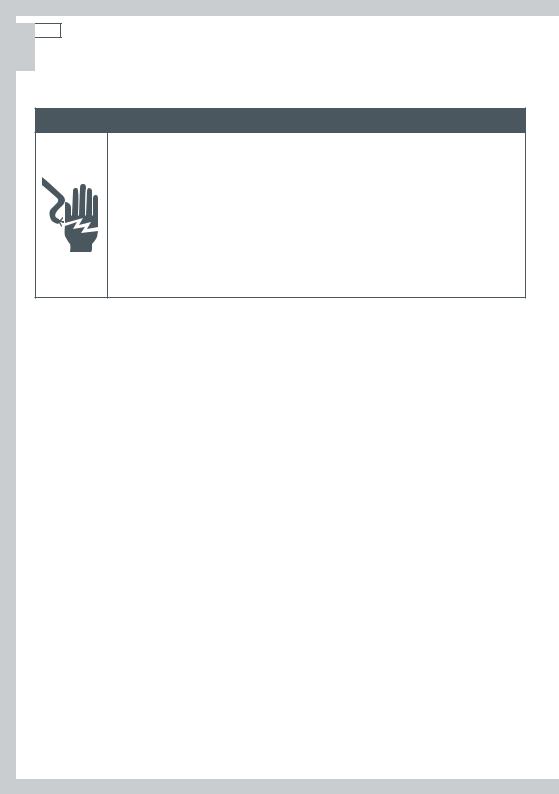
US 6 Installation instructions
CA
Before you begin – read these instructions completely and carefully.
 WARNING!
WARNING!
Electric Shock Hazard
Read and follow the IMPORTANT SAFETY Instructions outlined in this User Guide before operating this appliance, pages 3 – 5.
Improper connection of an equipment-grounding conductor can result in a risk of electric shock. Check with a qualified electrician or serviceman if you are in doubt as to whether the appliance is properly grounded.
Do not modify the plug provided with the appliance – if it will not fit the outlet, have a proper outlet installed by a qualified electrician.
Failure to do so can result in death, electric shock, fire or injury to persons.
Important!
Observe all governing codes and ordinances.
Installation Requirements
Location
Your washer must be installed on firm, level flooring to minimize vibration during spin cycles. Concrete flooring is best, but wood base is sufficient providing the floor support meets FHA standards.
Your washer must not be installed on any textured floor coverings (eg carpet, rugs) to ensure the opening at the bottom of the machine is not obstructed.
Your washer must also be installed where it is not exposed to the weather.
Plumbing
Water Temperature
Your cold water should not exceed 95˚F (35˚C) and your hot water should not exceed 149˚F (65˚C). Temperatures above this may damage your washer.
Shut Off Valves
Both hot and cold shut-off valves (faucets) should be available in the laundry area.
Drain
Water may be drained into a standpipe or tub/sink. The standpipe must be 1 ½” (38 mm) minimum interior diameter and must be open to the atmosphere.
Electrical
This appliance must be supplied with 110V – 120V, 60Hz electrical supply and connected to an individual, properly grounded branch circuit, protected by a 15 or 20 amp circuit breaker or time delay fuse.

|
|
|
Installation instructions |
|
|
7 |
US |
|
|
|
CA |
|
|
|
Water supply
■■This washer must be plumbed into both a hot and cold water supply or it will not work correctly. Please ensure that both hot and cold water are connected to the washer.
■■If you have an uncontrolled water-heating source (eg a wet back or solar heating) you should have a tempering device fitted. This will ensure the hot water temperature remains within safe limits. For the most suitable type of tempering device we recommend you contact a local plumber or plumbing supply merchant.
■■Inlet water static pressure: Min. 5psi (34kPa) to Max. 150psi (1MPa) is required.
■■Minimum flow rate from the faucet supplying the clothes washer should be greater than 1 ½ gallons/min (6 liters/min) (assumes ½” (12.7 mm) diameter pipes).
Note: your washer does not have an internal water heater to heat water.
Draining
■■Regularly check that your standpipe or tub/sink is free from lint or other obstructions, which may affect how your washer works or may cause flooding.
■■In multi-storey apartments or any upper floor, the washer should be installed on floor equipped with a drain.
■■Draining must comply with local by-laws.
Important!
If you are using an extension cord or a portable electrical outlet device (eg multi-socket outlet box), ensure that it is positioned so that it does not come into contact with water or moisture.
Accessories and spare parts
Available from your Fisher & Paykel Dealer or Authorized Service Center.
Drain Hose Extension |
Part No. 425627p |
Power Cord |
If the Power Cord of your clothes washer is damaged it must be |
|
replaced by a Fisher & Paykel Authorized Service Agent, as it is not a |
|
standard power cord. |
|
|
|
|

US 8 Installation instructions
CA
Washer end of hose
Specifications
Faucet end of hose
D |
|
|
|
|
A |
|
|
|
|
|
|
|
Standpipe height |
|
|
|
|
33 ½” to 94 1” |
|
|
|
|
(850 – 2400 mm) |
|
Allow for |
|
|
|
|
adjustable |
|
|
|
|
feet |
|
|
|
|
C |
B |
Inlet water pressure |
|
|
Max 150 psi (1MPa) |
|
|||
|
|
|
||
|
|
Min 5 psi (34kPa ) |
|
|
Fig.2 Washer dimensions and connections |
|
|
|
|
Dimensions |
|
|
|
|
Product dimensions |
|
|
inches |
mm |
A Overall height of product (to highest point on console)* |
41 3/4 – 43 |
1060 – 1090 |
||
B Overall width of product |
|
|
27 |
685 |
C Overall depth of product |
|
|
28 |
700 |
D Height (lid open)* |
|
|
56 3/4 – 57 7/8 |
1440 – 1470 |
* The exact height of your washer is dependant on how far the feet are extended from the base of the machine.
Note: the depth of the machine is the cabinet only, ie does not include the distance the inlet hoses and drain hose extend from the rear of the cabinet. Another 50 mm should be allowed for in the installation cavity to accommodate the inlet hoses and drain hose.

|
|
|
Installation instructions |
|
|
9 |
US |
|
|
|
CA |
|
|
|
Unpacking
To ensure the best performance from your new WashSmart clothes washer please follow the instructions below.
Removing the packaging
1Remove the outer packaging.
2Tilt the washer backwards and walk it off the base packer one foot at a time (ensure the lid remains taped down).
3Remove the base packer from under the washer by pulling it out from the front.
Important!
Fig.3 Tilt washer backwards to remove base packer
Operating the washer when the base packer is in place can result in damage to the washer. Ensure the base packer has been removed BEFORE OPERATING your washer.
4Remove the tape, lift the lid and remove the basket packer from the basket.
5Remove the hoses and accessories.
6Keep the base packer and basket packer in case they are required for future transit.
Installation
In your clothes washer you will find:
■■1 hose guide.
■■2 inlet hoses.
■■4 rubber foot inserts (if not already inserted into the feet of your washer).
■■1 User Guide
■■1 spirit level
Refer to page 6 for location installation requirements.
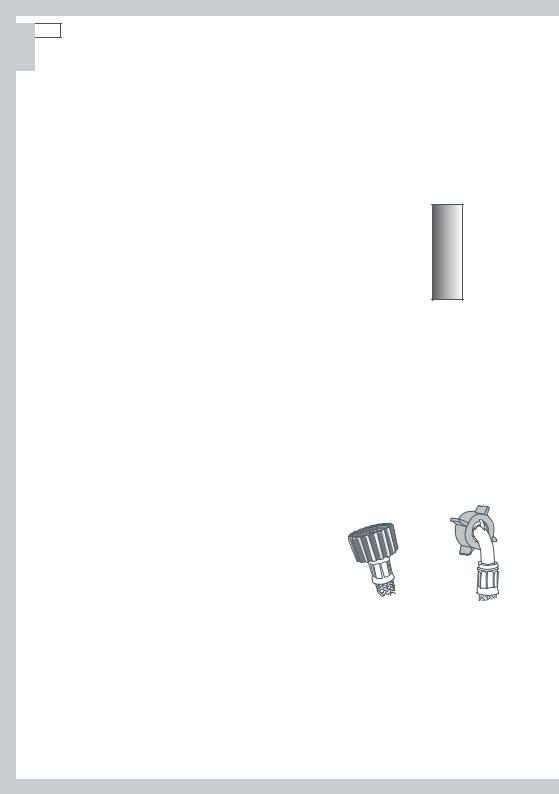
US 10 Installation instructions
CA
Drain hose
1Carefully pull the drain hose out from the back of the washer by pulling the exposed part of the hose downwards and outwards.
2To guide the drain hose over the tub/sink or standpipe the hose guide MUST be fitted to the drain hose.
Important!
To prevent siphoning the drain hose should not extend more than ¾” (20 mm) from the end of the guide. The height of the standpipe or tub/sink should be between 33 ½” to 95” (850 – 2413 mm).
The drain hose can be trimmed to length.
Pull hose through guide
Flex hose guide apart
Standpipe 33 ½” to 95” (850 – 2400 mm)
3 Place the drain hose in the tub/sink or standpipe. Do |
Fig.4 Fitting the drain hose guide |
not fit the hose to a drain spigot. Drainage must not |
|
be airtight in order to prevent siphoning. |
|
¾/4” (20 mm) maximum
Important!
■■In multi-story apartments or any upper floor installation, the washer should be installed on a floor that is equipped with a drain.
■■Check that the tub or standpipe is free from lint or other obstructions before operating the washer.
■■In a basement installation do not exceed a standpipe height of 96” (2438 mm).
Inlet hoses
Important!
■■New hose sets provided with the washer shall be used to connect the washer to the water mains.
■■Old hose sets should not be re-used.
1Install hoses with the straight end (with filters) fitted to the faucets (refer to Fig.5).
2Install elbow ends of hoses onto clothes washer inlet valves (refer to Fig.6). The valves are marked on the back of the washer (H=hot, C=cold). Ensure the hot valve is connected to the hot faucet and the cold valve is connected to the cold faucet.
Fig.5 Faucet end of |
Fig.6 Washer end of |
hose (straight end) |
hose (elbow end) |
Inlet hose replacement
Important!
The inlet hoses should be replaced every 5 years. Hoses should be checked from time to time and replaced if any wear, cuts, bulges, kinks or leaks are found. WARNING!: Failure to do so may result in a flood and damage to property.
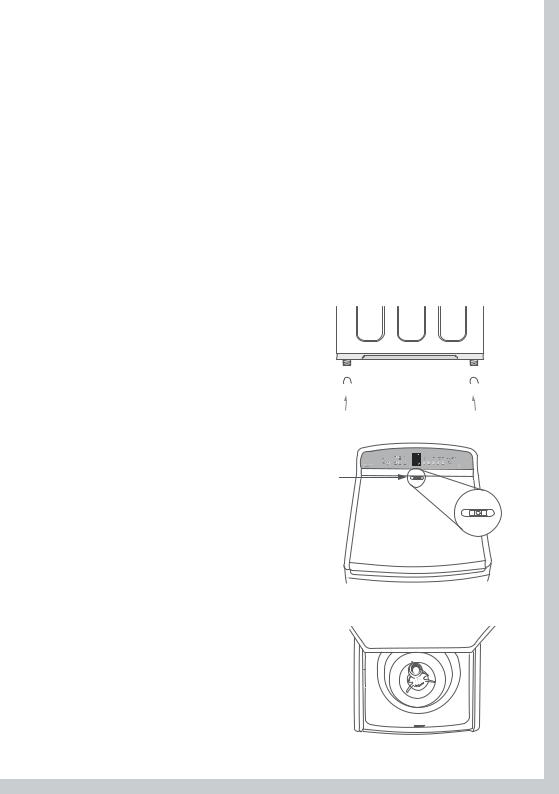
|
|
|
Installation instructions |
|
|
11 |
US |
|
|
|
CA |
|
|
|
Leveling instructions
It is IMPORTANT to level the machine to ensure good spin performance and effective detergent and fabric softener dispensing.
A spirit level is provided with your machine. Use this to level your machine, placing it bottom side down in the locations specified below (ensure the surfaces are clean). The machine is level when the bubble sits in the center, within the two lines.
Your washer is equipped with self-locking feet to ensure they do not move once you have leveled your machine. To adjust the feet, tip the washer back or forward to locate the foot you wish to adjust, pull down gently and then twist to move it up or down to the required level. Repeat if necessary.
Important!
After leveling, the corners of the washer should be clear of the floor (by at least 2/5” (10 mm) and the machine must not rock in any direction.
1If not already installed, fit the rubber inserts into all 4 feet on the base of the machine.
2Extend all 4 feet by three full turns before moving the machine to its final position.
3Move the machine to its final position using the top corners to manoeuvre the product into place (do not push against the center front of the machine). We recommend a minimum clearance of 3/4” (20 mm) each side and 2” (50 mm) at the rear of the machine.
4With the lid closed, place the spirit level at the center back of the lid (near the control panel). If not level, pull the machine out and adjust the rear feet until the machine is level side to side when in position.
5Open the lid. Place spirit level on the flat surface on the left side, inline with the center of the basket. If necessary, adjust the front left foot until the machine is level.

 Adjustable feet
Adjustable feet 



 Rubber insert
Rubber insert

Fig.7 Leveling – Step 1 & 2
Spirit level
Fig.8 Leveling – Step 4
Spirit level 

Fig.9 Leveling – Step 5

US 12 Installation instructions
CA
6Move the spirit level to the right side, in line with the center of the basket. If necessary, adjust the front right foot until the machine is level, and does not rock. There should
be equal weight on both front feet so that neither can be turned by hand when the machine is in position.
7Place the spirit level at the center front of the topdeck, forward of the lid lock slot. Check the machine is level. Adjust the front feet again if necessary. Move the spirit level around to all positions once more, checking the machine is level in all areas. Check the machine does not rock side to side, front to back, or corner to corner.
Important!
Spirit level
Fig.10 Leveling – Step 6
Spirit level
Fig.11 Leveling – Step 7
■■Keep your spirit level for the next time you move or reposition your washer.
■■If moving or transporting your washer in the future, ensure you tape the lid down beforehand.

|
|
|
Installation instructions |
|
|
13 |
US |
|
|
|
CA |
|
|
|
Completing your installation
■■Turn on the water and check all hose connections for leaks. Make sure there are no kinks in the hoses. Check the hose connections for leaks again after 24 hours.
■■Uncoil the power cord, remove and discard the plastic pin cover, and plug into power outlet and turn the power on.
Installation test cycle
Your washer must be correctly installed before use. Check the machine’s installation and operation using the following procedure:
1Touch POWER to activate your washer.
2Touch both the KEYLOCK and OPTIONS buttons at the same time, and hold for three seconds.
3Touch START/PAUSE to start the installation test cycle.
4The machine will beep to signal the end of the installation test cycle. Any faults will be displayed on the screen (refer to the back of this User Guide to help identify faults). If you need further assistance, please contact a Fisher & Paykel Customer Care Representative. Refer to page 47 for contact details.
Note: if there are no faults found, the washer will automatically turn off at the end of the installation test cycle.
Clothes washer safety
■■This clothes washer is not intended for use by persons (including children) with reduced physical, sensory or mental capabilities, or lack of experience and knowledge, unless they have been given supervision or instruction concerning use of the appliance by a person responsible for their safety.
■■The lid will be locked from the start of the cycle until the cycle is complete for safety reasons. To open the lid during operation, you must touch START /PAUSE.
■■Supervise children at all times to ensure they do not play with the washer.
■■The only user-removable parts of the washer are the inlet hoses and dispenser funnels. No other parts are designed to be removed by anyone other than a Fisher & Paykel Authorized Service Agent.
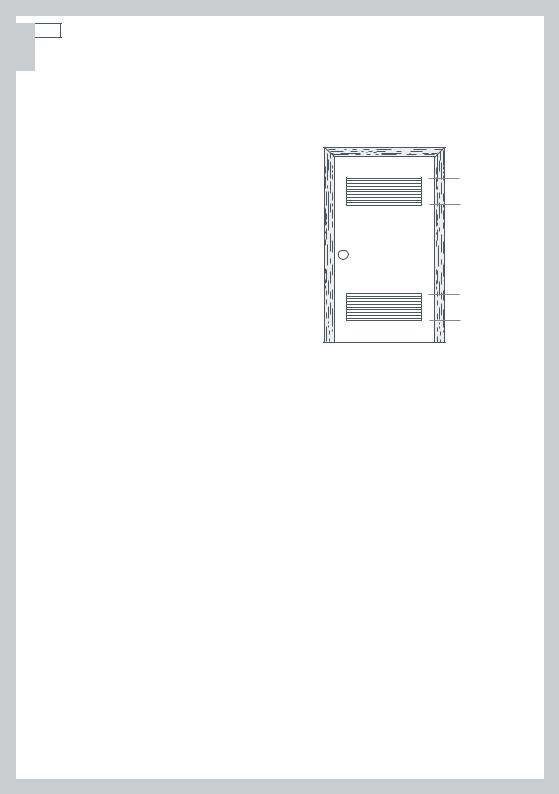
US 14 Installation instructions
CA
Special requirements for alcove or closet installation
The minimum ventilation clearance between the washer and adjacent walls or other surfaces is:
1” (25 mm) minimum either side and front 3” (75 mm) minimum rear
Consideration must be given to providing adequate clearance for installation and servicing.
The minimum vertical space required from floor to overhead shelves, cabinets, ceilings etc is 58” (1470 mm).
Closet doors must be louvered or otherwise ventilated and have at least 60 square inches of open area for a washer only, or if the closet contains both a washer and dryer, doors must contain at least 120 square inches of open area equally distributed.
60 Sq. In
(388 Sq. cm)
60 Sq. In
(388 Sq. cm)
Fig.12 Louvered door Washer & Dryer
Caution!
Do not install this appliance in a closet with a solid door.
Mobile home installation
Installation must conform to the STANDARD FOR MOBILE HOMES, ANSI A119.1 and NATIONAL MOBILE HOME CONSTRUCTION & SAFETY STANDARDS ACT OF 1974 (PL93-383).
Grounding instructions
This appliance must be grounded. In the event of malfunction or break down, grounding will reduce the risk of electric shock by providing a path of least resistance for electric current. This appliance is equipped with a cord that has an equipment-grounding conductor and a grounding plug. The plug must be plugged into an appropriate outlet that is properly installed and grounded in accordance with all local codes and ordinances.
Specification subject to change without notice.
Additional instructions
Cleaning your washer
Due to the water and energy efficient nature of your machine, regular cleaning of the inside of your washer is necessary and important. Please refer to page 37 for more information.
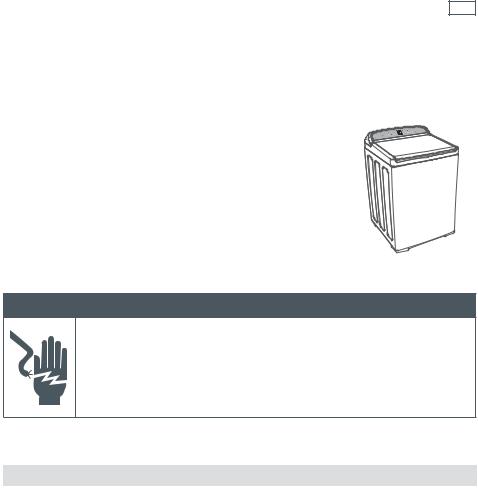
Before you do your first wash |
15 |
|
US |
||
|
|
CA |
|
|
|
You owe it to yourself and your Fisher & Paykel WashSmart to have it installed correctly by an Authorized Service Agent.
Before you start, it is a good idea to go through the following checklist:
1 Has the base packer been removed?
2 Is the drain hose threaded through the ‘U bend’ hose guide (with no more than ¾/4” (20 mm) extended) and hooked on to your standpipe or tub/sink?
3Is the hot hose connected to the hot valve marked ‘H’? Is the cold hose connected to the cold valve marked ‘C’?
4 Is the washer leveled correctly, with the feet extended and cabinet corners clear of the floor? Refer to pages 11 and 12.
5 Have you performed the installation test cycle? Refer to page 13.
 WARNING!
WARNING!
Electric Shock Hazard
Read and follow the IMPORTANT SAFETY INSTRUCTIONS outlined in this User Guide before operating this appliance, pages 3 – 5.
Failure to do so can result in death, electric shock, fire or injury to persons.
WashSmart water consumption
Load Size |
Regular* |
|
|
22 lb (10 kg) |
31 G (117 L) |
|
|
15.5 lb (7 kg) |
28 G (108 L) |
|
|
11 lb (5 kg) |
25 G (93 L) |
|
|
7 lb (3 kg) |
18 G (69 L) |
|
|
2 lb (1 kg) |
13 G (49 L) |
|
|
*Regular cycle is the default wash cycle for WashSmart.
Note: water consumptions are based on the WashSmart default settings.

US 16 Getting started quickly
CA
■■Place the load evenly around the agitator (refer to ‘Sorting’ and ‘Loading’, page 21).
■■Remove fabric softener dispenser cup.
Detergent
■■For the correct detergent dose, please follow the
manufacturer’s instructions, outlined on the detergent package.
■■ Use the mark on the agitator nearest to the top of the clothes as a guide to the correct amount of detergent to use (refer to ‘Detergent’, page 22).
■■Pour the detergent down the center of the agitator stem.
■■Replace the fabric softener dispenser cup (this stops
small articles falling down the center of the agitator |
Fig.13 Adding detergent |
when you load the machine). |
|
Fig.14 WashSmart control panel
1 5
Bleach
If you wish to use bleach:
■■Use half the recommended dose of bleach.
■■Dilute bleach with water and pour carefully down the inner surface of the agitator stem, in-line with the fins (refer to Bleach page 23).
■■Select the BLEACH option. This will ensure that any residual bleach is well rinsed out of your washer.
2
Fig.15 Adding bleach
|
Fabric softener |
■■ |
If you wish to use fabric softener, place it in the dispenser on the top |
|
of the agitator. |
■■Select the SOFTENER option so that the softener will be dispensed
correctly into the final rinse (refer to ‘Fabric softener’ page 23 and 29). Fig.16 Adding fabric softener
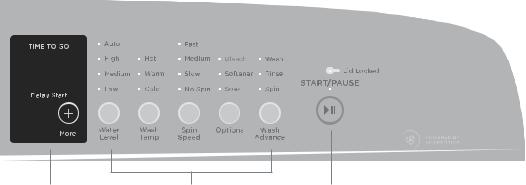
Getting started quickly |
|
|
17 |
US |
|
|
|
CA |
|
|
|
Using your washer
The SmartTouch™ buttons require only a gentle touch to activate.
1Touch POWER to activate your Fisher & Paykel WashSmart washer.
2Select your desired wash cycle by touching the corresponding button (refer to page 25).
3Choose your wash options, eg you may want a WARM wash temperature and a SLOW spin speed (refer to pages 26 – 30).
4Touch START/PAUSE to start the cycle. The washer will start to fill with water and select the correct wash action for your load.
■■For best fabric and color care, remove your clothes as soon as the cycle has finished.
5Use KEYLOCK mode to lock the buttons on the display, which prevents them from being activated accidently by a laundry basket or little fingers (refer to page 18).
6DELAY START allows you to delay the start of your wash by 5 mins up to 18 hours (refer to page 29).
6 |
3 |
4 |
If you wish to stop your WashSmart washer
■■Press START/PAUSE.
During a spray rinse or spin, there will be a slight delay while the basket slows to a stop and the lid is unlocked.
Important!
Failure to follow the advice in this guide may result in damage to your garments, and your expectations of wash performance may not be met.

US 18 WashSmart controls
CA
SmartTouch™ buttons
The smooth easy clean buttons require only a gentle touch to activate.
Digital display screen
The digital display screen provides feedback on how long the wash cycle has to go, to keep you informed throughout the cycle. The screen also displays your DELAY START selection, should you choose one. The delayed time remaining will show on the screen until the machine starts. The screen will also display messages to help you with the overall running of your machine.
Time to go
Your WashSmart washer will display how many minutes a wash cycle has remaining, so that you can tell at a glance when your washing will be finished. Once you have selected your wash cycle and options, the time the wash cycle will take to complete will be displayed. Please be aware that actual cycle times may vary as they are influenced by a number of factors, eg the flow rate of your water supply, the load size and cycle selection.
Keylock mode
Keylock can be used to lock the buttons on your WashSmart when not in use. This will avoid accidental button pushes from items left on the lid of the washer and also from any little fingers.
To turn Keylock mode ON or OFF:
■■Touch and hold the KEYLOCK button for 2 seconds.
Note: when activated, the light above the KEYLOCK button is illuminated.
If Keylock mode is activated:
■■To turn your washer on, touch and hold the POWER button for 2 seconds. This will activate the control panel. Keylock mode will remain activated but will allow you to select your wash cycle options and start the cycle.
■■To PAUSE your washer at any time during the cycle, touch and hold the START/PAUSE button for
2 seconds, or touch the START/PAUSE button twice in quick succession.
■■To STOP your washer or power off at any time, simply touch the POWER button.

WashSmart safety features |
|
|
|
19 |
US |
||
|
|
|
CA |
Lid lock |
|
|
|
|
|
|
|
The lid of your Fisher & Paykel WashSmart washer is locked |
|
|
|
during the wash cycle, ensuring safety for you and your family |
|
|
|
while it is operating. |
|
|
|
The “Lid Locked” light (above the START/PAUSE button) is |
|
|
|
illuminated when the lid lock is activated, letting you know at a |
|
|
|
glance if you can open the lid or not. |
|
|
|
To unlock the lid at any time during the cycle press |
Fig.17 Lid lock |
|
|
START/PAUSE. |
|
|
|
The lid will be locked from the start of the cycle, through to the end, unless START/PAUSE is touched.
If the lid is left open, your WashSmart washer will be unable to lock the lid, and the cycle will be halted. The machine will beep to alert you and display a warning message on the screen. If this occurs, close the lid and touch START/PAUSE.
Important!
■■Do not put anything down the lid lock slot in the top deck of your machine.
■■Do not try to disable the lid lock.
Ensure that children or infirmed persons are well supervised when around your WashSmart washer.
Auto drain
■■Unsupervised clothes washers filled with water can present a drowning hazard to small children. In order to minimize any risk of this type of accident, your WashSmart has been pre-programmed to know when this potential hazard is created and drains the wash water to a safe level.
■■If you pause your WashSmart at any time during the wash cycle when there is water in the basket, the machine will activate the AUTO DRAIN function after 3 minutes. This will drain the water in the wash basket to an acceptable level, minimizing any potential hazard.
■■A warning message (“Adr”) will be displayed on the digital display while AUTO DRAIN is in operation. The cycle can be restarted while AUTODRAIN is in operation by touching START/PAUSE.

US 20 Eco Active™ wash
CA
Your Fisher & Paykel WashSmart uses a dual-action wash to give excellent wash performance while taking great care of your clothes. We call this the Eco Active™ wash. The two parts to the Eco Active™ wash are explained below:
Wash 1 – Detergent activating wash (front-loader type wash)
Your WashSmart washer fills the basket at the selected temperature with just enough water so that your clothes are 100% saturated. This small amount of sudsy water flows down through the clothes, up a specially designed portal and back onto the clothes in a cascade effect. This wash action thoroughly dissolves and activates the detergent.
The concentrated solution of detergent and water |
|
|
rapidly targets stains and soils at the fiber-level of |
|
|
fabrics, boosting soil removal and accelerating the |
Fig.18 Eco Active™ wash |
|
wash process. |
||
|
Wash 2 – Agitation wash (top-loader type wash)
After recirculating the sudsy water through your clothes for 4 minutes, your WashSmart washer will fill with just enough cold water to suspend the clothes in solution. Agitation will then begin, moving soil away from the clothes.
Note: the detergent activating wash is the only time |
|
during the cycle that hot water is used (when the |
|
machine is completely full the water will be lukewarm). |
|
If you need hot water during the agitation part of the |
|
wash, select the ALLERGY cycle. |
Fig.19 Agitation wash |
Unique Fisher & Paykel spray rinse
Spray |
Spin |
Spray |
Spin |
Spray |
Spin |
Fig.20 Spray rinse
Sorting and loading |
|
|
21 |
US |
|
|
|
CA |
Sorting |
|
|
|
|
|
To get the best wash results it pays to sort your clothes before washing. |
|
|
Care labels |
|
|
The care label will tell you about the fabric of the garment and how it should be washed. |
|
|
Soil
Sort clothes according to the type and amount of soil. Some soils suit warmer washes, eg oily soils, while others are best washed in cold water, eg mud, blood.
Color
Sort white fabrics from colored fabrics.
Lint
Wash lint givers (eg towels, flannelette, nappies) and lint collectors (eg synthetic fabrics, socks) separately. Where possible, turn lint collectors inside out.
Loading
Check pockets
Loose items can damage both your washer and your clothes.
Close zippers, hooks and eyes
This is to make sure that these items do not snag on other clothes.
Mend any torn garments or loose buttons
Tears or holes may become larger during washing. Remove any loose bra wires as they can damage your washing machine and/or dryer.
Put very delicate items in a mesh laundry bag.
This is a good idea for lingerie items to provide them with extra protection, and helps prevent tangling with other items.
Pretreat any stains
Make sure you use an appropriate surface to apply treatments. Do not use the lid or top of the machine, as damage may occur to these surfaces.
Make sure the water level suits the load size
If manually selecting the water level, select the correct water level by using the mark on the agitator nearest to the top of the load. Ensure the load does not extend above the bottom of the fabric softener dispenser cup, as splashing may occur.
For a balanced load
■■Place unfolded clothes firmly and evenly around the agitator, no higher than the bottom of the fabric softener dispenser cup.
■■Do not wrap large items, such as sheets, around the agitator.
■■A mixture of small and large items will wash best.
Note: in the unlikely case of an out of balance load, refer to the Leveling instructions on page 11 to check the machine is correctly levelled.
Important!
Please do not, under any circumstances, attempt to wash an electric blanket in your washer. Nor is it recommended that you wash curtains in your washer, sunlight makes them brittle and they may disintegrate during washing.

US 22 Detergent
CA
Choosing the right detergent
■■We recommend using domestic laundry detergent. Use powder or liquid detergent designed for Top Loader machines.
■■When washing wool items, remember to use a detergent specifically recommended for woollens.
■■Soap flakes should not be used in your washer.
How much detergent?
Follow the instructions on the back of the detergent packet as a guide to the correct amount of detergent to use. The correct amount of detergent will vary, depending on the amount of soil in your clothes and the size of your load. Jeans and work clothes may need more detergent, while towels usually need less. The larger your machine, the more detergent you may have to add.
Adding the detergent
Liquid or powdered detergents
1Remove the fabric softener dispenser cup.
2Pour liquid or powder detergent down the center of the agitator.
Pre-dissolving detergent in warm water (before adding it to the machine) when washing in cold water may improve the performance of the detergent.
3Replace the fabric softener dispenser cup (this prevents small articles falling down the center of the agitator).
Fig.21 Adding your detergent
Important!
We do not recommend you use nappy sanitizer or bleach to soak items in your WashSmart washer. These products are very corrosive to metal surfaces and may seriously damage your machine.

Before you wash |
23 |
|
US |
||
|
|
CA |
|
|
|
Bleach
Remember to check clothing labels before you begin to ensure that garments are bleach-compatible.
Liquid bleach:
1Use half the recommended dose of bleach and dilute with water before adding to your washer.
2Remove the fabric softener dispenser cup and pour down the inside edge of the agitator stem, in line with the fins. Select the BLEACH option. This changes the rinse to ensure thorough removal of any bleach residue.
3Add detergent and replace the fabric softener dispenser.
4Load clothes into the wash basket.
5Start the wash cycle.
Fig.22 Selecting BLEACH option
Powdered bleach:
Pour half the recommended dose of powdered bleach into the agitator with your detergent.
■■When washing colored items, please ensure you use color-safe bleach.
■■If you are using liquid detergent use a liquid color-safe bleach.
■■Add clothes to the wash basket AFTER bleach has been added.
Important!
Never pour undiluted, liquid chlorine bleach directly onto clothes, into the wash tub, or straight down the center of the agitator. Irreversible damage to your clothing may occur.
Fabric softener
The fabric softener goes into the dispenser cup on the top of the agitator. The ring on the dispenser cup is a guide for the amount of fabric softener to add for a full load. Smaller loads require less fabric softener.
Softener rinse
If you wish to use fabric softener when using the REGULAR or HEAVY DUTY cycles you must select the SOFTENER option. This changes the rinse option to include a deep rinse so the fabric softener will be dispensed correctly.
Note: we recommend the use of softener dryer sheets because liquid fabric softener has been known to cause an unpleasant build up inside washing machines.
Fig.23 Selecting SOFTENER option
In addition, some wash loads are better washed using a cycle with a deep rinse. For instance, garments that have a lot of sand or sawdust in them, or garments where the color still runs. For these loads select the SOFTENER option, as this will change the rinse to include a deep rinse.

US 24 Before you wash
CA
Scrud
Scrud is the name given to the waxy build-up that can occur within any washer when fabric softener comes into contact with detergent. This build-up is not brought about by a fault in the machine. If scrud is allowed to build-up in the machine it can result in stains on your clothes or an unpleasant smell in your washer.
If you wish to use fabric softener we recommend:
■■Using fabric softener sparingly.
■■When filling the dispenser, do not splash or overfill.
■■Clean the fabric softener dispenser as soon as the cycle is finished (refer page 37).
■■Clean your machine regularly (refer page 37).
■■Cold water washing increases the chance of the build-up occurring.
■■We recommend that a warm wash be used at regular intervals, eg every 5th wash should be warm.
■■Fabric softener of a thinner consistency is less likely to leave residue on the dispenser and contribute to a build-up.

Wash cycles |
25 |
|
US |
||
|
|
CA |
|
|
|
Your WashSmart has a number of wash cycles available. Selecting the most appropriate cycle for each wash load will help ensure you get the best possible wash result.
The wash cycles
REGULAR |
For medium to lightly soiled cottons, linens, work and play clothes. |
|
|
|
|
HEAVY DUTY |
For heavily soiled and heavy duty fabrics. |
|
|
|
|
DELICATE |
For lingerie and special-care fabrics with light soil. |
|
|
|
|
EASY IRON |
A more traditional wash for synthetics, blends, and/or delicate fabrics with |
|
normal soil and clothes which wrinkle easily. |
||
|
||
|
|
|
ALLERGY |
Specially designed for asthma sufferers and people with sensitive skin. |
|
|
|
|
QUICK |
For lightly soiled garments requiring a freshen up. |
|
|
|
Note: condensation may form on the outside of the washer when using the ALLERGY cycle in cold weather. This is due to the hot water wash temperature and cold outside temperature, and is normal.
Wash cycles – default settings
|
REGULAR |
HEAVY |
DELICATE |
EASY IRON |
ALLERGY |
QUICK |
|
|
|
|
|
|
|
|
|
Wash time* |
13 – 15 min |
15 – 17 min |
5 min |
9 min |
13 – 15 min |
3 min |
|
|
|
|
|
|
|
|
|
Wash action |
REGULAR |
HEAVY |
DELICATE |
REGULAR |
REGULAR |
REGULAR |
|
|
|
|
|
|
|
|
|
Wash temp |
WARM |
WARM |
WARM/COLD |
WARM/COLD |
HOT |
WARM/COLD |
|
|
|
|
|
|
|
|
|
Rinse |
Spray rinse |
Spray rinse |
Sprays/ |
Sprays/ |
Sprays/ |
Sprays/ |
|
Deep rinse |
Deep rinse |
2 Deep rinses |
Deep rinse |
||||
|
|
|
|||||
|
|
|
|
|
|
|
|
Spin speed |
FAST |
FAST |
SLOW |
MEDIUM |
FAST |
FAST |
|
|
|
|
|
|
|
|
|
Spin time** |
6 min |
6 min |
4 min |
4 min |
6 min |
4 min |
|
|
|
|
|
|
|
|
*Refers to the agitation time in the “wash” part of the cycle, not the total time taken to complete a cycle.
**Refers to the length of time when at the maximum speed.
Note: some options may not be available on some cycles for garment care reasons (eg FAST spin on the DELICATE cycle).
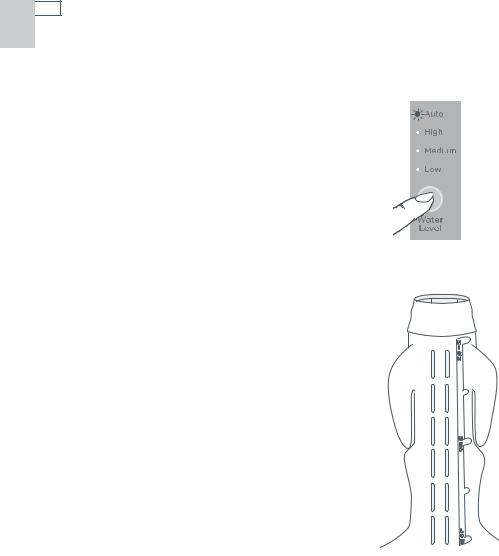
US 26 Wash options
CA
Water level
Auto water level
Your washer has the ability to automatically select the most efficient water level for the load.
1Place your clothes in the machine.
2Select the wash cycle (and select AUTO water level if not automatically selected).
3Touch START/PAUSE. The machine will automatically fill to the correct water level for the load, for both phases of the wash and the rinse.
■■When washing an unusual load, eg large bulky garments, water-proof or water resistant items or pillows, we recommend you manually select the most suitable water level, and select the DELICATE cycle.
■■If there is already water in the basket, it is best to manually select the water level.
Manual water level selection
The agitator has five levels marked on its stem that can be used to help you select the correct water level. Select the correct water level by using the mark nearest to the top of the load.
■■The levels marked on the agitator do not correspond exactly to the level of the water. They indicate the level of dry clothes suitable for the water level.
■■Your washer may occasionally add water during agitation. This is to maintain the water level due to the release of air trapped in the garments.
■■Out of balance loads, tangling or splash-over can be caused by selecting a water level that is too high.
Fig.24 Selecting
AUTO water level
Fig.25 Water level guide on agitator

Wash options |
27 |
|
US |
||
|
|
CA |
|
|
|
Wash temp
The water temperature is monitored by a sensor which controls hot and cold water inputs to deliver uniform wash temperatures.
Touch the WASH TEMP button to increase or decrease the wash temperature selected. The wash temperature selected is used in the Eco Active™ part of the wash (refer to page 20); the temperature will be lower for the remaining part of the wash (with the exception of the ALLERGY cycle where the basket fills with water at the temperature selected).
The temperature of cold faucet water varies widely depending on your location and the season. We have developed CONTROLLED COLD, which adds a small amount of warm water, when necessary, to raise your cold water wash to 68°F (20°C) for a more effective wash. Refer to pages 32 – 34 for detail on how to set CONTROLLED COLD as the default temperature for your cold water wash.
Fig.26 Wash Temperature options
We recommend selecting the most suitable wash temperature for the fabric and the type of soil to be removed. Always refer to the item’s care label for the manufacturer’s recommended washing instructions.

US 28 Wash options
CA
Spin speed
Your washer offers 3 spin speeds: FAST (maximum 1100 rpm), MEDIUM (670 rpm) and SLOW (330 rpm), plus an additional NO SPIN option. The default spin speed for each cycle can be changed. Simply increase or decrease your spin speed by touching the SPIN SPEED button.
Not all spin speed options are available on some cycles for best clothes care (eg DELICATE cycle).
Use the NO SPIN option to:
■■Remove drip dry garments from a mixed load before you proceed the washer to its final spin.
Fig.27 Selecting the NO SPIN option
■■Minimize the clothes wrinkling when they are left to sit in the bottom of the basket at the end of the cycle.
When you have selected NO SPIN, the cycle will end after the rinse, allowing you to remove drip dry items. Once drip dry items have been removed, touch POWER, select the SPIN cycle (change the SPIN SPEED if necessary, eg select SLOW for delicate or creasable items) and touch START/PAUSE.
Note: your washer will optimize the spin speed according to the level of out of balance in the load.
Wash advance
Sometimes you may not need to run a full wash cycle. Use WASH ADVANCE to advance the current cycle or to start a cycle at a particular stage, ie to complete a rinse and spin, or to perform a spin only.
Fig.28 Advancing the wash cycle
